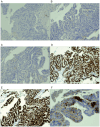Metastatic papillary thyroid carcinoma in the soft tissue of the breast in a male patient: A case report
- PMID: 39697978
- PMCID: PMC11653250
- DOI: 10.3892/ol.2024.14841
Metastatic papillary thyroid carcinoma in the soft tissue of the breast in a male patient: A case report
Abstract
Papillary thyroid carcinoma (PTC) represents ~80% of all thyroid cancers, most frequently presenting in women in the third and fourth decade of life. The first clinical manifestation of PTC commonly includes a palpable mass in the thyroid area or cervical lymphadenopathy in cases of metastatic disease. Hematogenous distant metastases are a sign of an advanced stage of the tumour. The present study reported an extremely rare occurrence of solitary metastasis of a PTC in the left breast of a 63-year-old male patient, mimicking primary male breast cancer (MBC). The presence of a male breast lesion that did not follow the typical imaging criteria for MBC aroused suspicion of a different primary origin. The combination of imaging methods, laboratory findings and fine-needle aspiration techniques enabling cytological and histopathological examination, with the use of a wide panel of immunohistochemical markers, is crucial to establishing a definitive and correct diagnosis.
Keywords: PTC; breast metastasis; mediastinal mass; soft-tissue metastasis.
Copyright: © 2024 Maráčková et al.
Conflict of interest statement
The authors declare that they have no competing interests.
Figures






Similar articles
-
Intermixed medullary and papillary thyroid cancer in a patient with renal cell carcinoma.Endocrinol Diabetes Metab Case Rep. 2020 Jun 4;2020:20-0025. doi: 10.1530/EDM-20-0025. Online ahead of print. Endocrinol Diabetes Metab Case Rep. 2020. PMID: 32538376 Free PMC article.
-
Papillary thyroid carcinoma with hyperthyroidism and multiple metastases: A case report.Medicine (Baltimore). 2020 Jul 24;99(30):e21346. doi: 10.1097/MD.0000000000021346. Medicine (Baltimore). 2020. PMID: 32791734 Free PMC article.
-
Incidental Solitary Adrenal Metastasis as the Initial Manifestation of a Solid Variant of Papillary Thyroid Carcinoma, With Emphasis on Pathologic Diagnosis and Clinical Management.AACE Clin Case Rep. 2022 Jan 13;8(3):131-134. doi: 10.1016/j.aace.2022.01.002. eCollection 2022 May-Jun. AACE Clin Case Rep. 2022. PMID: 35602883 Free PMC article.
-
Breast cancer metastases to the thyroid gland - an uncommon sentinel for diffuse metastatic disease: a case report and review of the literature.J Med Case Rep. 2017 Sep 22;11(1):269. doi: 10.1186/s13256-017-1441-x. J Med Case Rep. 2017. PMID: 28934992 Free PMC article. Review.
-
Metastatic rectal cancer to papillary thyroid carcinoma: a case report and review of literature.BMC Gastroenterol. 2020 May 6;20(1):136. doi: 10.1186/s12876-020-01286-z. BMC Gastroenterol. 2020. PMID: 32375670 Free PMC article. Review.
References
-
- Podolski A, Castelluci E, Halmos B. Precision medicine: BRAF mutations in thyroid cancer. Precis Cancer Med. 2019;2:29. doi: 10.21037/pcm.2019.09.04. - DOI
Publication types
LinkOut - more resources
Full Text Sources
